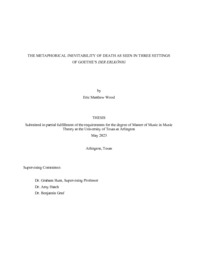
ATTENTION: The works hosted here are being migrated to a new repository that will consolidate resources, improve discoverability, and better show UTA's research impact on the global community. We will update authors as the migration progresses. Please see MavMatrix for more information.
Show simple item record
| dc.contributor.advisor | Hunt, Graham | |
| dc.creator | Wood, Eric | |
| dc.date.accessioned | 2023-06-14T17:05:55Z | |
| dc.date.available | 2023-06-14T17:05:55Z | |
| dc.date.created | 2023-05 | |
| dc.date.issued | 2023-05-10 | |
| dc.date.submitted | May 2023 | |
| dc.identifier.uri | http://hdl.handle.net/10106/31234 | |
| dc.description.abstract | Goethe’s Der Erlkönig, published in 1791, laid the foundation for many musical settings of its text. The three that will be discussed in this thesis are by Franz Schubert (1815), Carl Loewe (1824), and Emilie Mayer (1870). Each of these three settings evokes the metaphorical concept of inevitability. In Mayer’s setting, the harp-like accompaniment pattern that follows the Erlking suggests a calm presence, but the text shows the Erlking’s true nature. Loewe’s setting is entirely in G (major and minor), which I interpret as two sides of the same coin– the positive false reality that the Erlking provides and the truth of the situation that the father and son are in. In my interpretation, Schubert’s setting provides the strongest connection to the inevitable death of the child in the text. I argue that a large-scale Expanded Cadential Progression (first brought to light by Caplin) deep in the tonal structure of this setting provides a progression of inevitability leading to the end of the work. Utilizing Caplin’s formal function theory and Schenker’s linear analysis and expanding on past research by Burkhart, I intend to further explore the links between the original text and settings of Der Erlkönig. | |
| dc.format.mimetype | application/pdf | |
| dc.language.iso | en_US | |
| dc.subject | Schubert | |
| dc.subject | Der Erlkönig | |
| dc.title | The Metaphorical Inevitability of Death as Seen in Three Settings of Goethe's Der Erlkönig | |
| dc.type | Thesis | |
| dc.date.updated | 2023-06-14T17:05:55Z | |
| thesis.degree.department | Music | |
| thesis.degree.grantor | The University of Texas at Arlington | |
| thesis.degree.level | Masters | |
| thesis.degree.name | Master of Music | |
| dc.type.material | text | |
| dc.creator.orcid | 0009-0000-9653-3159 | |
Files in this item
- Name:
- WOOD-THESIS-2023.pdf
- Size:
- 10.40Mb
- Format:
- PDF
This item appears in the following Collection(s)
Show simple item record


